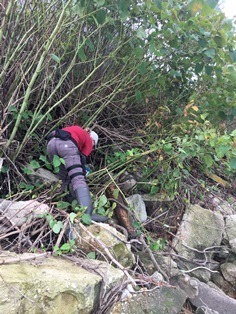|
Jan. 18, 2018
Contact: Joanne Foreman, 517-284-5814
State awards $3.6 million in grants to combat invasive species
The Michigan departments of Environmental Quality, Natural Resources, and Agriculture and Rural Development today announced that 23 projects will share $3.6 million in state grants through the Michigan Invasive Species Grant Program, an initiative launched in 2014 to help prevent and control invasive species within the state.
The program targets four key objectives:
- Preventing new introductions of invasive species through outreach and education.
- Monitoring for new invasive species and the expansion of existing invasive species.
- Responding to and conducting eradication efforts for new findings and range expansions.
- Strategically managing and controlling key colonized species.
“Michigan’s Invasive Species Grant Program provides vital support to our partners throughout the state in the fight against invasive species,” said DNR Director Keith Creagh. “Protecting our world-class woods and waters to ensure these valuable natural resources remain healthy and accessible to current and future generations is one of our most important priorities. These grant dollars will go a long way toward making that happen.”
Covering 100 percent of Michigan's 83 counties
 In 2018, the Michigan Invasive Species Grant Program is funding two new Cooperative Invasive Species Management Areas (CISMAs), meeting a program metric of providing management services to every county in Michigan: In 2018, the Michigan Invasive Species Grant Program is funding two new Cooperative Invasive Species Management Areas (CISMAs), meeting a program metric of providing management services to every county in Michigan:
- The Jackson Conservation District is awarded funding to initiate the Jackson, Lenawee and Washtenaw Cooperative Invasive Species Management Area.
- The St. Joseph Conservation District will lead the development of the Southern Michigan Invasive Species Team, serving Branch, Hillsdale and St. Joseph counties.
Ten existing CISMAs across the state will receive grants this year to continue providing invasive species education and assistance to citizens and agencies in their regions.
Battling hemlock woolly adelgid
Over $850,000 is awarded to three projects to survey, map and treat trees infested with hemlock woolly adelgid as a part of a statewide response strategy to detect and manage this tree-killing pest.
Hemlock woolly adelgid can kill hemlock trees in as little as four years. Its establishment threatens the more than 170 million hemlock trees that grow in Michigan’s forests and landscapes.
Treatments will occur in Allegan, Muskegon, Oceana and Ottawa counties, where outbreaks have been documented, and survey efforts will span an additional 10 counties along Lake Michigan to determine the extent of the infestation.
Managing aquatic invaders
Grant funding will support a broad range of aquatic invasive species efforts, including:
- Testing responses of different Eurasian watermilfoil hybrids to herbicide treatments to improve management of this invasive plant that is plaguing Michigan’s waters.
- Evaluating control options for European frogbit, an invasive plant spreading along Michigan’s eastern coastline.
- Assessing methods of grass carp management in Lake Erie to improve future efforts and inform early-detection actions for other invasive carp species not yet in the Great Lakes.
- Providing opportunities to paddlers and other recreational users on 12 water trails across the state to identify, report and reduce the spread of aquatic invasive species through a comprehensive outreach and education project.
The full list of grant recipients, project descriptions and award amounts is available on the Michigan Invasive Species Grant Program website.
The DNR began accepting grant applications for this funding cycle in June 2017. After the original call for pre-proposals (which yielded 68 applications seeking more than $12 million), the department received 35 full proposals requesting $6.2 million in support. Grant applicants were asked to commit to providing at least 10 percent of the total project cost in the form of a local match.
Learn more about invasive species in Michigan at www.michigan.gov/invasivespecies.
/Note to editors: Accompanying photos are available below for download. Suggested captions follow.
CISMA: Staff of Cooperative Invasive Species Management Areas across the state work hard to manage invasive species like Japanese knotweed, shown here being injected with herbicide by a West Michigan CISMA employee. Photo courtesy WMCISMA.
Fighting_hemlock_woolly_adelgid: Tom Tucker of the Michigan DNR's Parks and Recreation Division applies an approved insecticide to an infested hemlock tree at Muskegon State Park./
The Michigan Department of Natural Resources is committed to the conservation, protection, management, use and enjoyment of the state’s natural and cultural resources for current and future generations. For more information, go to www.michigan.gov/dnr.
|

 In 2018, the Michigan Invasive Species Grant Program is funding two new
In 2018, the Michigan Invasive Species Grant Program is funding two new 




